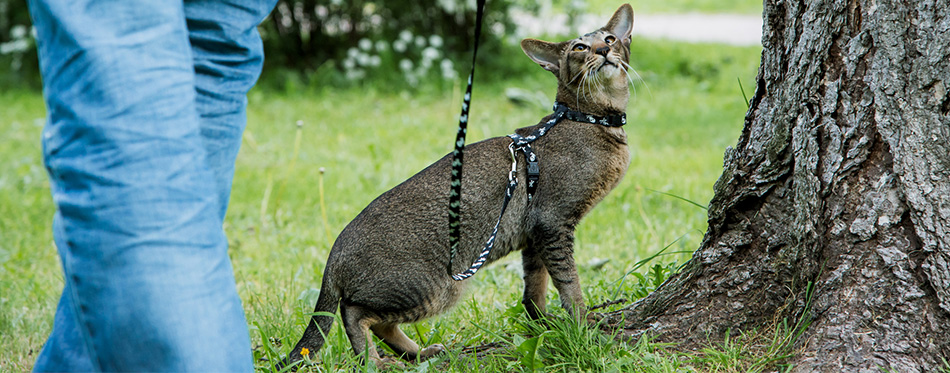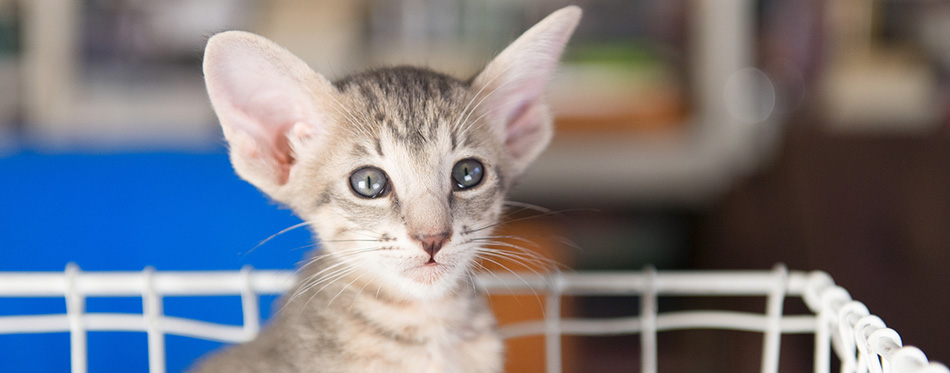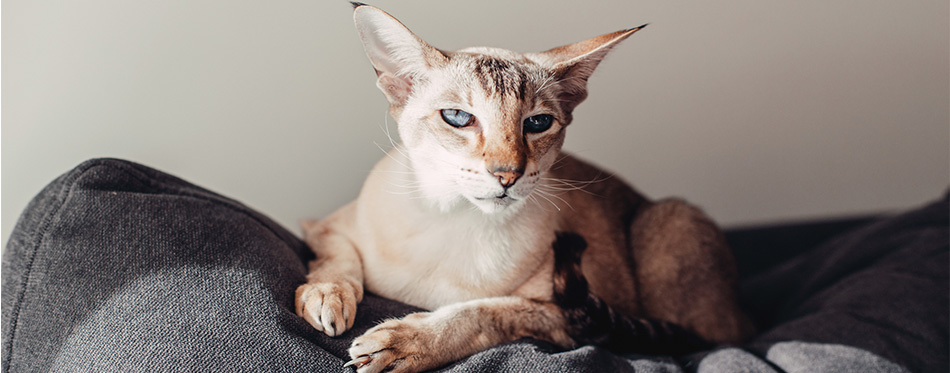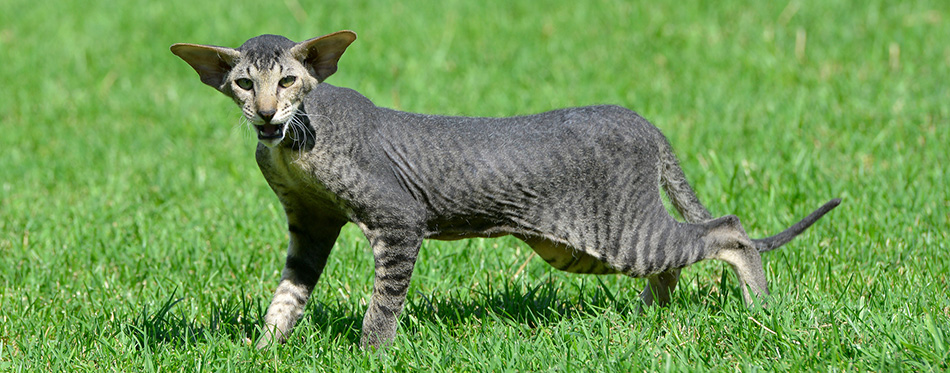With nearly 300 different colors and patterns, you may wonder how you would be able to tell what an oriental cat looks like. Well, in fact they are very distinctive. But they also have character traits which make them stand out in the cat world as well. In this blog post, we are going to look at various aspects of Oriental cat which will help you to understand them and give you some of the advice you need if you are thinking of getting one yourself. Alternatively, you may already own one and want some specific questions answering. Check out this guide to see what sort of useful info you can glean.

History of the Oriental Cat
Let’s start with a quick look at the history of oriental cats. As you may have already guessed, they are naturally close to Siamese cats, which can be traced back to Thailand, formally known as Siam. They were revered for their elegant appearances, and at some point in time, brought back to England. Though the exact date cannot be accurately specified. British breeders liked the look of the Siamese, but wanted more colors and patterns.
During the 1950s and 1960s, Siamese cats were crossed with two other breeds – British Shorthairs and Russian Blues to create what is modernly referred to as an Oriental cat. American breeders also created their own Orientals by crossing Siamese felines with American Shorthairs and Abyssinians. However, breeders were initially wary about another Siamese cat competing with the originals. But this didn’t stop the Oriental from skyrocketing in popularity and being accepted by the cat fanciers association (CFA) in 1972.
Quick Facts About the Oriental Cat
Oriental cats are known for their long and slender bodies, piecing oval-shaped eyes (which are usually blue, green, or one of each), and large ears. Over 300 different colors have been documented, but a few popular shades include pure white, ebony, and tabby. Their coats are short and sleek, which makes them easy when it comes to grooming. Generally, they have a coloring which is pale, but their extremities including their ears, tails, and feet tend to be darker than the Siamese cats that they originated from.
In terms of personality, they have high energy levels, which means that they take more upkeep than other moggies. This is the type of cat that doesn’t enjoy being ignored, so prepare for them to demand plenty of your time and attention. If you ignore them for too long, you could find that they start to become a little unhappy.
Ideally, you should have plenty of time to care for your Oriental cat. They do well in busy households with other pets that can keep them entertained too. But their affectionate nature also makes them great companions for people who spend a lot of time indoors. What they don’t like is being left alone for long periods of time.
One of the most distinctive character traits of Oriental cats is their vocalization. They love speaking with their owners, and they are known for a voice which can be described as low and raspy.

Things You Should Know
The next section goes into more detail about various aspects of owning an Oriental cat. We have broken these down into easy sub-headings to help you find the information that you are looking for easily.
Health
First, let’s start by looking at the health of Oriental cats. Thankfully, this is quite a resilient breed that doesn’t suffer from too many inherited health issues. In a good home with the right care, they can generally live for 12 years or longer. However, a couple of the issues that can affect them are caused by their unusual head shape and facial features. If you have a young kitten, a couple of the problems that you need to be on the lookout for include upper respiratory infections and feline rhinotracheitis viruses. Usually, these can be treated quickly with the right veterinary care and attention. Other issues are related to their eyes. These include progressive retinal atrophy, which your cat won’t display symptoms for if they only have one gene, but if both parents are carriers, it can be a problem. Feline glaucoma is another potential issue, but it is not normally a serious one.
As for none facial issues, there is amyloidosis, which occurs when a type of protein known as amyloid is deposited in the organs of your cat. It the liver that is normally impacted in cats from the Siamese family. However, despite some of these concerns, Oriental cats are genetically healthier than some other purebreds, which is a relief for many would-be owner.
Feeding
The basic diet of Oriental cats has traditionally consisted of meat, and this is what should form the cornerstone of their food intake these days. Like other cats, they are carnivores and don’t really need fruit and vegetables to stay happy and healthy. Also, rather than just offering them one large meal during the day, it is better that they have several smaller meals instead. Of course, this is not something that is feasible with many people’s busy routines, so you may have to cut this down to just a couple of times in a day.
There are plenty of commercial cat foods available, which most people find to be the most convenient feeding option. These exist in three main varieties: dry, moist, and semi-dry. The type of meat or fish can vary, so you may just have to experiment with your cat until you find out what they enjoy eating. However, you may want to vary this up from time to time so you don’t have a fussy cat who only eats a single variety of food. Some owners prefer to give their Oriental cat just a dry food diet, which is good for their teeth, but you need to make sure that there is plenty of water down as your cat will not be getting the moisture that they need from their food alone. Check the type of food is suitable for the age of your cat as there are different varieties for kittens, adult cats, and senior felines. Remember to wash out your cat’s bowl every time they have finished eating to get rid of any bacteria remaining. After all, you wouldn’t want to eat from a dirty plate, so why should your cat eat from a dirty bowl?
Oriental cats don’t really need anything specific beyond what you would offer to other kitties. Look for food that provides the full range of nutritional benefits including protein, fats, carbs, vitamins, and minerals. Oily fish such as sardines or pilchards can be useful in keeping the coat of your cat nice and shiny. However, don’t overdo this rich food. Watch your cat’s calorie count if you think that they are starting to put on excess weight as obesity is one of the most dangerous conditions for a feline in terms of their health. And Orientals are known for getting a bit of a pot belly after they have indulged in overeating. Remember that their legs are long and slim, so they may not be able to hold up a heavy body easily. Treats can also form a part of their diet, but they should only consist of around 10 percent. There are plenty of branded cat food treats out there, or you can offer them bits of cooked meat, fish, or eggs.
For more guides on choosing the right cat food, you may wish to check out our reviews of the best wet cat food, senior cat food, hypoallergenic cat food, cat food for sensitive stomachs and cat food for constipation.

Care
Now, we come onto the issue of general care for Oriental cats. If you are getting a kitten, you can expect them to be quite large and strong. Their bodies should be what you could describe as ‘filled out’. Their coats should be shiny and eyes clear. In terms of their personality, they should be curious and willing to interact with you. When you pet them, they should purr – and after initial anxieties are overcome, they should come to you on their own.
The process of adoption can be quite daunting if you have never done it before. When sourcing a breeder, you should aim for a good reputation, and you should aim for a personal recommendation if this is possible. You should ask to see the mother and father of the kitten as this can give you a better idea of health and temperament. Kittens should not be sold when they are under 13 weeks of age. You should expect to see a full vaccination certificate. Consult with your vet about what you should see on this document. In terms of price, anything in the $1,000 mark is normal. Beware if the price seems like it is too good to be true.
We have already talked about the importance of a good diet, but exercise is another crucial component of care. Oriental cats are known for their playful nature, so you should be prepared with plenty of games and toys for your new cat to enjoy. Try to clear some space at home where they can bound around. A cat tower and/or cat window perch gives them the chance to climb and get up to the higher ground that they seek. Bear in mind that Orientals are known for being able to jump up high and run over long distances. You may even be able to teach them to play fetch like a dog! And if you have enough time and patience, you can even train them to walk on a leash, so you can bring them into the outside world safely.
The other main thing to talk about when it comes to care is making sure to spend enough time with your cat. While other kitties are happy enough with their alone time, Orientals can get upset, which leads them to acting out. This is one of the reasons why they are so at home in busy households with kids and other pets. If you have young kids, make sure that you teach them to play gently from a young age so you can have a happy family.
Grooming
While there are plenty of important points in looking after an Oriental Cat, grooming doesn’t come particularly high on the list. Their coat remains silky and shiny without a great deal of upkeep. And they don’t have the long hair and shedding problem that is common in long-haired felines. However, this doesn’t mean that you should ignore grooming your cat entirely. Petting them and brushing with your fingers or a gentle brush helps to dislodge and loose hair and encourages new fur to grow. Don’t overdo it as this can lead to negative things like bald patches. But many Orientals love being brushed as you are giving them plenty of love and attention, so you may notice your cat purrs while you are grooming them. If you do this every few weeks, this should be fine.
Beyond looking after their coat, you also have the other grooming activities to think of. These include cleaning out their ears and trimming their nails. Providing them with a cat scratching post is useful in allowing them to work out their natural scratching energy. An often overlooked aspect of cat care is brushing their teeth, and this is a habit which is worth getting into from a young age. There are all manner of brushes out there including traditional toothbrushes and finger brushes. If you don’t want your cat to suffer from dental problems later in life, you should brush their teeth at least on a weekly basis. However, more often is better if you can spare the time.
For more help on cat grooming, you may wish to read our guides on the best cat ear cleaners, cat nail clippers, brushes for cats, cat grooming gloves, cat toothbrushes and cat shampoos.
Temperament
In terms of their personality, their parallels with Oriental cats are quite apparent. While some cats tend to sit there quietly without having much to say, this cannot be said about Oriental cats, who are known for their distinctive raspy voices. If only you could understand exactly what they were trying to tell you! But the longer you have your cat, the more likely it is that you will get used to their rhythms and desires.
Oriental cats are known for being fun and playful rather than placid and disinterested, so they will appreciate having lots of toys to play with – as well as people to keep them company and come up with inventive games. Otherwise, they are likely to become bored, and this could manifest itself in the destruction of your possessions as your kitty attempts to make their own entertainment! As we have mentioned earlier in the blog post, Orientals are known for their excellent jumping ability, and they love to reach high places. Perches and cat trees are worthwhile investments as you know that they are climbing up safely rather than putting themselves at risk of falling. For a wider selection of choices, check out our cat toys guide.
As Oriental cats love activity and entertainment, they do well in busy households with plenty of company including kids and other animals. But they can also suit people who spend a lot of time indoors who are looking for the companionship. What they don’t like is being left alone for a long time, so if you live a busy life and are out of the house a lot of time, they may not be the ideal cat for you. A possible solution is to get them a companion cat, but this is best suited to younger felines as cats can become quite territorial once they have a stable home environment. Ideally, you should introduce this new pet into the house in stages, so they don’t feel overwhelmed all at once.
When your cat has used much of the energy after a busy day of playing, they are likely to want to curl up on your lap to sleep. And if you allow it, they may also enjoy sleeping next to you in bed! In many ways, it is like having a child in your house, which is exactly what some people are looking for in a pet, but others may want a kitty who is a little less high maintenance. Ultimately, this is a choice that you have to make yourself based on your personality and exactly what you are looking for in a pet.

Final Thoughts
There are plenty of positive aspects about owning an Oriental cat, and this blog post has given you a good overview of many them. They are fun loving and affectionate cats, who don’t require a huge amount of grooming work. There aren’t many health problems to speak of and their dietary requirements aren’t too complex. However, this is the kind of cat who doesn’t enjoy being alone for long periods of time, so they are best suited to busy households and owners who can give them the love and attention that they deserve. Make sure that you adopt from a recognized breeder if you are going to go down this route. Ask all the appropriate questions and ensure that they are in good health, so you get a cat who you can love for years to come.
Source:
- About the Oriental – The Cat Fanciers’ Association

